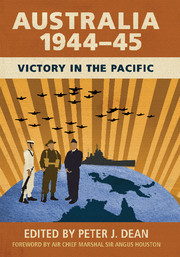Book contents
- Frontmatter
- Dedication
- Foreword
- Contents
- Maps and chart
- Figures and table
- Contributors
- Acknowledgements
- Abbreviations
- Military symbols on maps
- Introduction
- PART 1 STRATEGY
- PART 2 AUSTRALIA AT WAR
- 4 The Long Silence: Australian Prisoners of the Japanese
- 5 Total War on the Australian Home Front, 1943–45
- PART 3 GREEN ARMOUR AND SPECIAL OPERATIONS
- PART 4 THE NAVAL AND AIR WAR
- PART 5 THE NEW GUINEA CAMPAIGN
- PART 6 THE BORNEO CAMPAIGN
- Afterword: And Then Came Peace?
- Index
- References
4 - The Long Silence: Australian Prisoners of the Japanese
from PART 2 - AUSTRALIA AT WAR
Published online by Cambridge University Press: 05 December 2015
- Frontmatter
- Dedication
- Foreword
- Contents
- Maps and chart
- Figures and table
- Contributors
- Acknowledgements
- Abbreviations
- Military symbols on maps
- Introduction
- PART 1 STRATEGY
- PART 2 AUSTRALIA AT WAR
- 4 The Long Silence: Australian Prisoners of the Japanese
- 5 Total War on the Australian Home Front, 1943–45
- PART 3 GREEN ARMOUR AND SPECIAL OPERATIONS
- PART 4 THE NAVAL AND AIR WAR
- PART 5 THE NEW GUINEA CAMPAIGN
- PART 6 THE BORNEO CAMPAIGN
- Afterword: And Then Came Peace?
- Index
- References
Summary
In retrospect, there is an air of inevitability about the Allied victory in the Pacific War. Even for those not inclined to economic determinism, there is inexorable logic about the application of the United States’ prodigious military power, industrial production and technological expertise. No doubt many Australians living through the war sensed this by early 1944. Not only had the Japanese thrust southwards been halted, but US forces had also launched their island-hopping campaign that would lead ultimately to the doorstep of Japan. However, Tarawa was a long way from Tokyo, and no one could predict in 1944–45 how long the war would last and precisely when it would end.
This was a particular agony for the families of those who had been taken prisoner of war in the Asia-Pacific region. Very little had been heard of these men and women since the Japanese forces overwhelmed Hong Kong, Malaya, Singapore, the Netherlands East Indies and New Britain in late 1941 and early 1942. The Japanese authorities had consistently failed to provide the affected Allied governments (notably Australia, Canada, the Netherlands, the United Kingdom and the United States) with detailed nominal rolls of the units they had captured. Nor would they allow the International Committee of the Red Cross (ICRC) to access camps south of Hong Kong, where the vast majority of Australians were thought to be interned. Many Australian personnel had, in effect, disappeared behind a wall of silence.
However, it was known from the unofficial information that leaked out from Japanese-occupied territories from late 1943 that the Japanese were not observing the 1929 Geneva Convention Relative to the Treatment of Prisoners of War. Though not formally a party to this convention, they had promised to abide by its regulations mutatis mutandi. Yet the stories leaking out told of forced labour, malnutrition, disease and high death rates in camps south of Hong Kong. Only in north Asia, where the Japanese allowed the ICRC delegates to visit prisoner-of-war camps, was the treatment of prisoners known to be reasonable, at least by the standards of the local countries.
- Type
- Chapter
- Information
- Australia 1944–45Victory in the Pacific, pp. 79 - 97Publisher: Cambridge University PressPrint publication year: 2015



